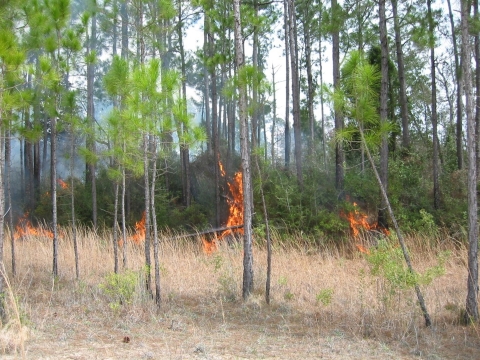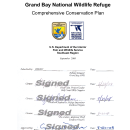What We Do
Wildlife conservation is at the heart of the National Wildlife Refuge System. It drives everything on U.S. Fish and Wildlife Service lands and waters managed within the Refuge System, from the purposes for which a national wildlife refuge national wildlife refuge
A national wildlife refuge is typically a contiguous area of land and water managed by the U.S. Fish and Wildlife Service for the conservation and, where appropriate, restoration of fish, wildlife and plant resources and their habitats for the benefit of present and future generations of Americans.
Learn more about national wildlife refuge is established to the recreational activities offered to the resource management tools used. Using conservation best practices, the Refuge System manages Service lands and waters to help ensure the survival of native wildlife species.
Habitat Restoration
Restoring the habitat to its previous open wet pine savanna state is a long-term program. Prescribed burning and mechanical clearing effectively maintains the open grasslands. Burning is a particularly efficient method of removing dense, shrubby vegetation and invasive species invasive species
An invasive species is any plant or animal that has spread or been introduced into a new area where they are, or could, cause harm to the environment, economy, or human, animal, or plant health. Their unwelcome presence can destroy ecosystems and cost millions of dollars.
Learn more about invasive species without damaging the soil.
Fire in the Savanna
Fire is a naturally occurring phenomenon throughout the longleaf and slash pine ecosystem and has shaped the appearance of the landscape over time.
When explorers first arrived in the Southeast, they recorded their observations of the landscape. Large acres of open savanna stretched from Louisiana to Florida, with widely scattered trees.
A mosaic of saw palmetto, carnivorous plants, herbaceous plants, and riparian riparian
Definition of riparian habitat or riparian areas.
Learn more about riparian drains of maples and oaks were the norm. The wet pine savanna was and still is one of the most diverse plant communities in North America. Only today, it's just a remnant - only 3-5% of the savanna remains.
Such diversity is dependent upon regular prescribed fire, keeping the area open for sun-loving herbaceous plants, as well as giving native longleaf pines and other native plants the conditions they need to thrive.
Historically, natural fire occurred on a three to five-year interval. Fires were of low intensity, fueled by grasses and pine litter. Prescribed fire simulates natural fire. Fire management officers write a prescription for fire to be ignited only when certain weather, fuel and moisture conditions occur that will make the fire manageable.
The prescribed fire program at the refuge strives to return the wet pine savannas to a natural condition, providing suitable habitat for native plant communities such as wiregrass and pitcher plants.
A Fire-Dependent Ecosystem
The native plants of the southeast are well adapted to fire. Many species are not just fire-tolerant, but even fire-dependent.
One example is the of a fire-dependent plant is the longleaf pine. Mature pines are fire-tolerant with multiple layers of bark to protect the core of the tree during a fire. Longleaf needles effectively protect their growing points during fires, allowing them to continue thriving after the burn. In addition, the seeds of the longleaf are shed only after the cones have been warmed by fire. Seedlings stay in a low-growing “grass stage” that survives as fires sweep over them, then seem to have a growth spurt often referred to as a "jump" after a burn.
Wire grass is another example of a fire-dependent savanna species. Only after being burned during the growing season will this grass produce seeds. Their complex system of underground roots and shoots helps them survive the fire.
These open wet pine savannas are important for many declining populations of grassland bird species that use the savanna.
To simulate the natural conditions that the wet pine savanna is adapted to, prescribed fire at the refuge is mainly applied in the fall and spring. Fall fire is used to improve savannas overstocked with planted slash pine. Spring (growing season) fire is used to clear unwanted woody vegetation from savannas that have grown up into brush thickets. This brush shades out native, desirable herbaceous plants . Spring fire improves the growth response of herbaceous plants while reducing the viability of the woody plants.
The Mechanics of a Prescribed Burn
Prescribed burning is a complex science known as "Fire Ecology". Trained firefighters look at weather conditions, ground moisture, habitat conditions and more to determine when and how to burn an area.
Important mechanical work installs "firelines" which act as the borders of the burn unit. Some firelines can be roads or bayous. They are often disced mineral lines which have a lack of fuel that will stop the fire from creeping across the line. During a burn, firefighters closely monitor these lines to ensure that they stop the fire effectively.
Fire is often applied using handheld drip torches. Firefighters complete lines of fire which burn and create a black area around the boundary of the fire - increasing the size of the fireline.
Once substantial black has been burned in the unit, it's time to burn the inner acres.The inner acres of the burn are often done by aerial ignition. Aerial ignition spheres that look like 'ping-pong balls" are dropped from a helicopter in a special machine that starts a chemical reaction within the spheres. The spheres ignite spot fires that burn together within the target area.
In this way, large acreages can be burned safely and efficiently. Smoke is less of a problem with these fires. Since smoke blows from burn areas with the prevailing winds, burns are planned when a favorable wind is forecast which will carry the smoke away from developed areas and main highways.
Fire and Wildlife
Wildlife such as deer, small mammals and reptiles escape the prescribed fire by running ahead of the fire or seeking cover in dens or holes in the ground. Very few animals perish in prescribed fires because the spot fires burn with less intensity than wildfire that is driven by the wind.
Burned areas are almost immediately used by wildlife who seek invertebrates, roots and other delectables in the newly uncovered ground.
Depending on weather conditions, units can "green up" with new growth within days or weeks of a burn.
Trapping Occurs on this Refuge
Trapping occurs on this refuge. Trapping is a wildlife management tool used on some national wildlife refuges. Trapping may be used to protect endangered and threatened species or migratory birds or to control certain wildlife populations. The U.S. Fish and Wildlife Service also views trapping as a legitimate recreational and economic activity when there are harvestable surpluses of fur-bearing mammals. On this refuge trapping occurs only as a wildlife management tool and is prohibited for the public. Outside of Alaska, refuges that permit trapping as a recreational use may require trappers to obtain a refuge special use permit. Signs are posted on refuges where trapping occurs. Contact the refuge manager for specific regulations.


